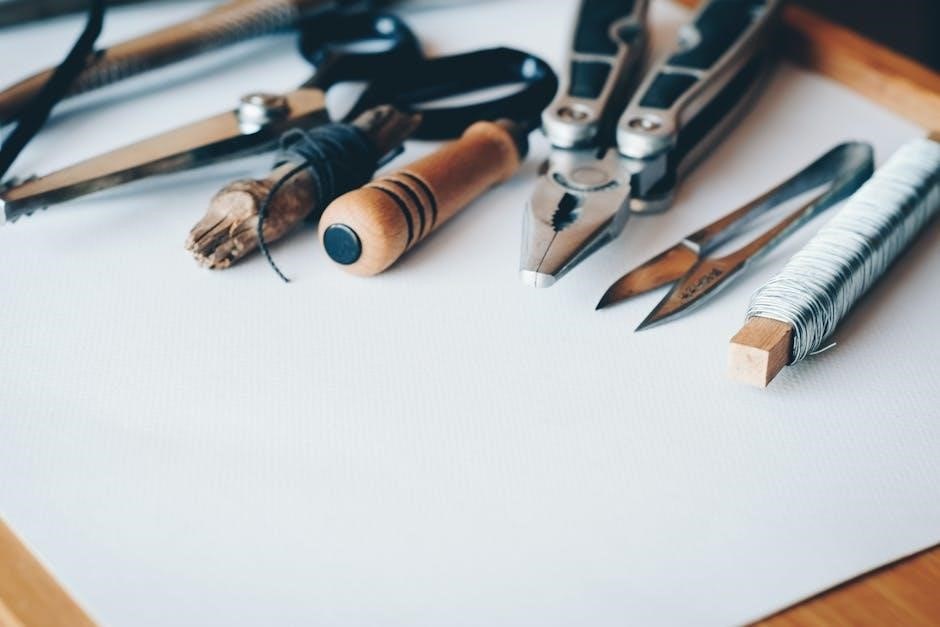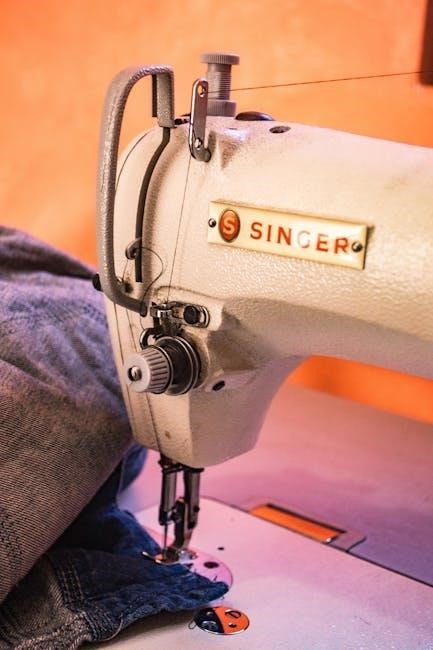Product Overview
The Pentair 320 Chlorinator is an automatic in-line feeder designed for pools and spas‚ compatible with chlorine and bromine․ It ensures consistent sanitizer levels‚ promoting water safety and clarity․ Compact‚ durable‚ and easy to use‚ it’s a reliable solution for maintaining clean pool water efficiently․
1․1 Key Features of the Pentair 320 Chlorinator
The Pentair 320 Chlorinator is an automatic in-line feeder designed for pools and spas‚ compatible with both chlorine and bromine․ It features a compact‚ durable design with a user-friendly control dial for easy adjustment of feed rates․ The chlorinator includes a check valve to prevent backflow and a large capacity for holding tablets or sticks․ Its robust construction ensures reliable performance‚ while its straightforward operation makes it a practical choice for maintaining clean and safe pool water year-round․
1․2 Benefits of Using the Pentair 320 Chlorinator
The Pentair 320 Chlorinator simplifies pool maintenance by providing consistent sanitizer levels‚ ensuring clean and safe water․ Its compatibility with both chlorine and bromine offers flexibility for different pool care needs․ The automatic feeding system reduces manual effort‚ while the large capacity minimizes refills․ Easy adjustment of feed rates allows precise control‚ optimizing sanitizer usage․ This chlorinator is designed to enhance water clarity and safety‚ making it a convenient and efficient solution for pool owners seeking hassle-free maintenance and superior performance․
Installation Guide
The Pentair 320 Chlorinator installation requires proper setup to ensure efficient operation․ Refer to the provided PDF manual for detailed‚ step-by-step instructions and safety guidelines․
2․1 Pre-Installation Checks
Before installing the Pentair 320 Chlorinator‚ ensure compatibility with your pool or spa system․ Verify all components are included and undamaged․ Check local regulations for compliance․ Ensure proper water flow and pressure ratings match your setup․ Familiarize yourself with the installation manual․ Turn off the pool pump and drain the system if necessary․ Wear protective gear when handling chlorine or bromine․ Ensure the installation area is clean and accessible․ Properly align the chlorinator with the pool’s plumbing system for optimal performance․ Follow all safety guidelines to avoid potential hazards during the process․
2․2 Step-by-Step Installation Process
Turn off the pool pump and drain the system if necessary․ Mount the chlorinator in an accessible location‚ ensuring it’s level and secure․ Connect the inlet and outlet pipes according to the manual․ Install the check valve in the bypass line to prevent backflow․ Attach the control valve and ensure proper alignment․ Fill the chlorinator with chlorine or bromine tablets/sticks‚ then set the dial to the recommended level․ Turn the pump back on and test for leaks and proper function․
2․3 Post-Installation Testing
After installation‚ inspect the system for leaks by checking all connections and valves․ Turn on the pool pump and monitor the chlorinator’s operation․ Ensure the control valve is functioning correctly and adjust the feed rate as needed․ Test the chlorine or bromine levels in the pool water using a test kit to confirm proper sanitizer distribution․ Refer to the user manual for specific testing procedures and recommended settings to ensure optimal performance and safety․

Operation and Maintenance
Regularly monitor chlorine levels‚ clean the feeder‚ and inspect for wear․ Adjust settings as needed to maintain optimal pool sanitation and system efficiency․
3․1 Daily Operation Tips
- Check chlorine levels daily to ensure proper pool sanitation․
- Adjust the feeder settings as needed based on pool usage and weather;
- Inspect the chlorinator for visible wear or blockages․
- Clean the feeder regularly to maintain optimal performance․
- Monitor the system for consistent operation and address any issues promptly․
3․2 Regular Maintenance Schedule
Perform monthly checks on the chlorinator’s settings and connections to ensure proper function․ Clean the feeder every 2-3 months by rinsing with water to remove debris․ Inspect the O-rings and gaskets for signs of wear and replace them annually․ Check chlorine levels weekly and adjust as needed․ Lubricate moving parts every 6 months to maintain smooth operation․ Regularly inspect the check valve for blockages and clean or replace it if necessary․ Schedule annual professional servicing to ensure optimal performance and longevity of the system․
3․3 Troubleshooting Common Issues
If the chlorinator isn’t feeding chlorine‚ check the check valve for blockages or damage․ Ensure the feeder is properly aligned with the pool’s water flow․ Low chlorine levels may indicate a clogged feeder or incorrect settings․ Clean the feeder regularly and adjust the dial as needed․ Leaks around connections can be resolved by tightening loose fittings or replacing worn O-rings․ If issues persist‚ refer to the user manual or contact Pentair support for assistance․ Regular maintenance can prevent many of these common problems․
Replacement Parts and Accessories
Key replacement parts include O-rings‚ lids‚ and check valves․ Genuine components ensure optimal performance and longevity․ Purchase from Pentair or authorized dealers to maintain warranty validity and reliability․
4․1 Identifying Replacement Parts
Identifying replacement parts for the Pentair 320 Chlorinator involves checking the unit for worn or damaged components like O-rings‚ lids‚ or check valves․ Refer to the manual for part numbers and diagrams․ Genuine parts are essential for maintaining performance and warranty validity․ Look for authorized dealers or Pentair’s official website to ensure authenticity․ Regular inspection helps prevent malfunctions‚ and replacing parts promptly ensures optimal chlorinator function and pool water safety․ Always consult the manual or contact support for accurate part identification and compatibility․
4․2 Where to Buy Genuine Parts
Genuine replacement parts for the Pentair 320 Chlorinator can be purchased directly from Pentair’s official website or through authorized dealers․ Online retailers like Amazon and PoolSuppliesPlus also offer verified Pentair products․ Ensure to verify the seller’s authenticity to avoid counterfeit items․ For assistance‚ contact Pentair’s customer support or refer to the manual for a list of approved distributors․ Buying genuine parts ensures compatibility‚ optimal performance‚ and maintains your product’s warranty․ Always check for part numbers and descriptions to confirm suitability for your specific model․
4․3 Installing Replacement Parts
Installing replacement parts for the Pentair 320 Chlorinator requires careful attention to detail․ Begin by turning off the system and draining the line to ensure safety․ Remove the old part by disconnecting any connections or fasteners․ Install the new part securely‚ following the manual’s specific instructions․ Reassemble the system and test for leaks or proper function․ Always refer to the manual for exact steps‚ as procedures may vary depending on the part being replaced․ If unsure‚ contact Pentair support for assistance․

Manual and Documentation
The Pentair 320 Chlorinator manual provides detailed installation‚ operation‚ and maintenance instructions․ Digital copies are available online‚ ensuring easy access to guidance and troubleshooting support․
5․1 Understanding the User Manual
The Pentair 320 Chlorinator manual is a comprehensive guide detailing installation‚ operation‚ and maintenance․ It includes troubleshooting tips‚ safety precautions‚ and warranty information․ The manual is structured for easy navigation‚ with clear instructions for both novice and experienced users․ Key sections cover feeder operation‚ chlorine/bromine settings‚ and diagnostic procedures․ Digital versions are accessible online‚ ensuring users can reference the guide anytime․ By following the manual‚ users can optimize the chlorinator’s performance‚ ensuring safe and efficient pool sanitation․ Proper adherence to the manual’s instructions is essential for longevity and effectiveness;
5․2 Navigating the Installation Manual
The installation manual for the Pentair 320 Chlorinator is organized to guide users through setup step-by-step․ It begins with pre-installation checks‚ followed by detailed instructions for mounting and connecting the feeder․ Diagrams and illustrations are included to clarify complex steps․ The manual also covers electrical connections and initial startup procedures․ Tips for proper placement and alignment ensure optimal performance․ By following the manual’s structured approach‚ users can complete the installation efficiently and safely‚ avoiding common pitfalls․ Referencing the manual during each step ensures a smooth setup process․
5;3 Accessing Digital Copies of Manuals
Digital copies of the Pentair 320 Chlorinator manual are readily available online․ Users can download the PDF version from Pentair’s official website or authorized distributors․ The manual is also accessible through the Pentair Rainbow 320 resource library․ Ensure to verify the file size‚ such as the 1․19 MB version‚ for authenticity․ Digital manuals offer convenient access‚ searchable content‚ and eco-friendly benefits․ They can be downloaded for offline use or printed as needed‚ providing flexibility for installation and maintenance tasks․ Always refer to the official sources to avoid outdated or incorrect versions․
Safety Precautions
Handle chlorine and bromine with care‚ wearing protective gloves and eyewear․ Follow maintenance guidelines to avoid exposure and ensure safe operation of the Pentair 320 Chlorinator․
6․1 Handling Chlorine and Bromine
When handling chlorine or bromine for the Pentair 320 Chlorinator‚ wear protective gloves‚ goggles‚ and a mask to prevent skin and eye irritation․ Ensure the area is well-ventilated to avoid inhaling fumes․ Always follow the manufacturer’s instructions for adding tablets or granules to the feeder․ Never mix chlorine and bromine directly‚ as this can produce harmful gases․ Store chemicals in a cool‚ dry place away from children and pets․ Proper handling ensures safe and effective pool sanitization․
6․2 Safety Guidelines for Maintenance
Before performing maintenance on the Pentair 320 Chlorinator‚ ensure the system is powered off and depressurized to avoid injury․ Wear protective gloves and eyewear to prevent exposure to chemicals or sharp edges․ Use approved tools to avoid damaging components․ Never over-tighten connections‚ as this may cause leaks or damage․ Keep the area well-ventilated and avoid breathing in chemical fumes․ Always follow the manufacturer’s instructions for maintenance procedures to ensure safety and system longevity․

6․3 Emergency Procedures
In case of a chemical spill‚ wear protective gear and contain the spill immediately․ Neutralize chlorine or bromine spills with sodium thiosulfate․ If a gas leak occurs‚ evacuate the area and contact a professional․ For electrical issues‚ turn off power and avoid water contact․ In case of skin or eye exposure‚ rinse thoroughly with water and seek medical help․ Keep emergency contact numbers handy‚ including Pentair support and local authorities․ Always follow proper first aid and safety protocols to ensure a safe resolution․

Troubleshooting Common Issues
Identify and resolve issues like check valve malfunctions‚ feeding problems‚ or leaks; Clean or replace faulty parts‚ adjust settings‚ and inspect for damage to ensure proper function․
7․1 Diagnosing a Non-Functional Check Valve
To diagnose a non-functional check valve in the Pentair 320 Chlorinator‚ inspect for visible damage or debris․ Ensure proper installation and alignment․ Check for mineral buildup or corrosion‚ which can impede flow․ Test the valve by manually opening and closing it to confirm smooth operation․ If issues persist‚ replace the valve to maintain optimal chlorinator performance and prevent system malfunctions․
7․2 Resolving Feeding Issues
If the Pentair 320 Chlorinator is not feeding chlorine or bromine properly‚ check the chlorine level in the pool․ Ensure the feeder is correctly installed and aligned․ Inspect the feeder for blockages or debris‚ which may restrict flow․ Clean or replace the filter if necessary․ Verify that the control dial is set appropriately for pool size and usage․ If issues persist‚ consult the manual or contact Pentair support for further assistance to restore proper feeding functionality․
7․3 Addressing Leaks and Other Malfunctions
Leaks or malfunctions in the Pentair 320 Chlorinator often stem from worn or damaged components․ Inspect the unit for cracks or loose connections‚ especially around the lid and tubing․ Tighten any loose fittings and replace damaged O-rings or seals․ If the issue persists‚ check for blockages in the feeder or control valve․ Clean or replace clogged parts as needed; For severe leaks‚ consider replacing the lid assembly or other faulty components․ Always refer to the manual for specific repair instructions or contact Pentair support for professional assistance․

Comparison with Other Models
The Pentair 320 Chlorinator stands out for its durability and ease of use‚ offering superior chlorine and bromine feeding efficiency compared to other inline models․
8․1 Pentair 320 vs․ Other Inline Chlorinators
The Pentair 320 Chlorinator excels in durability and user-friendliness compared to other inline models․ Its robust design ensures consistent chlorine and bromine feeding‚ while its compact size makes it ideal for various pool setups․ Unlike competitors‚ it offers a wide flow rate range‚ accommodating different pool sizes․ Additionally‚ its easy-to-use control dial and clear indicators simplify operation‚ making it a preferred choice for both residential and commercial applications․ Its reliability and performance set it apart in the market․
8․2 Key Differences in Features and Performance
The Pentair 320 Chlorinator stands out with its precise control dial for adjusting sanitizer levels and its high-capacity design‚ accommodating larger pools․ Unlike competitors‚ it supports both chlorine and bromine‚ offering flexibility․ Its durable construction ensures a longer lifespan‚ while its easy-to-use interface and high flow rate capacity make it ideal for various pool sizes․ These features‚ combined with its reliable performance‚ make the Pentair 320 a top choice for consistent and efficient pool sanitation․

Warranty Information
The Pentair 320 Chlorinator is backed by a limited warranty covering manufacturing defects․ For detailed terms and conditions‚ refer to the official Pentair website or product manual․

9․1 Understanding the Product Warranty
The Pentair 320 Chlorinator warranty covers manufacturing defects for a specified period․ It ensures repairs or replacements free of charge if issues arise due to faulty materials or workmanship․ The warranty typically excludes damage from improper installation‚ misuse‚ or normal wear and tear․ For precise details‚ including duration and coverage‚ consult the official Pentair website or the product manual provided with your purchase․ Understanding the warranty terms helps maximize protection for your investment․
9․2 Filing a Warranty Claim
To file a warranty claim for the Pentair 320 Chlorinator‚ visit the official Pentair website and navigate to the support section․ Locate the warranty claims form‚ fill it out with your product details‚ and attach proof of purchase․ Describe the issue clearly and submit the form․ Alternatively‚ contact Pentair customer support directly for assistance․ Ensure all documentation is complete to avoid delays․ Claims are typically processed within a few business days‚ with repairs or replacements handled promptly upon approval․
Customer Support and Resources
Pentair offers comprehensive support through their website‚ including manuals‚ FAQs‚ and contact options․ Online forums and community resources provide additional troubleshooting and maintenance tips for optimal performance․
10․1 Contacting Pentair Support

For assistance with the Pentair 320 Chlorinator‚ customers can contact Pentair support through their official website or by phone․ The support team is available to address installation‚ maintenance‚ and troubleshooting inquiries․ Additionally‚ online resources such as FAQs and user manuals are accessible to help resolve common issues․ Pentair also offers a dedicated customer service portal for submitting warranty claims and requesting replacement parts․ Ensure to have your product serial number ready for efficient support․
10․2 Online Resources and Community Forums
Pentair offers a comprehensive library of digital resources‚ including installation manuals‚ troubleshooting guides‚ and how-to videos for the 320 Chlorinator․ Community forums and support groups provide valuable insights and tips from experienced users․ These platforms allow pool owners to share solutions‚ ask questions‚ and learn from others․ Additionally‚ Pentair’s official website features a dedicated section for FAQs‚ ensuring easy access to information․ These resources empower users to maintain and troubleshoot their chlorinator effectively‚ fostering a supportive community for optimal pool care․
How to Choose the Right Chlorinator
Selecting the right chlorinator involves considering pool size‚ sanitizer type‚ and automation needs․ The Pentair 320 is ideal for in-line systems‚ offering efficient chlorine and bromine feeding‚ ensuring optimal water quality and convenience for pool maintenance․
11․1 In-Line vs․ Off-Line Chlorinators
In-line chlorinators like the Pentair 320 are installed directly into the pool’s plumbing system‚ providing continuous sanitizer feeding․ Off-line models‚ while similar in function‚ are typically more complex to integrate․ In-line systems are preferred for their simplicity and efficiency‚ ensuring consistent chlorine or bromine levels without additional setup․ This design makes the Pentair 320 a practical choice for pool owners seeking hassle-free maintenance and reliable performance;
11;2 Selecting the Proper Pool Chlorinator
Choosing the right chlorinator depends on pool size‚ type‚ and maintenance preferences․ The Pentair 320 is ideal for pools requiring consistent sanitizer levels‚ compatible with both chlorine and bromine․ Consider pool size to ensure the chlorinator’s capacity matches your needs․ For smaller pools‚ a lower-capacity model may suffice‚ while larger pools require higher-output systems․ Additionally‚ ease of use and maintenance should be evaluated to ensure the chlorinator aligns with your lifestyle and pool care routine․

Best Practices for Pool Care
Regularly test and adjust chlorine levels‚ clean the pool and its surroundings‚ and inspect equipment to ensure optimal performance and safety with the Pentair 320 Chlorinator․
12․1 Maintaining Proper Chlorine Levels
Maintaining proper chlorine levels is crucial for water safety and clarity․ The Pentair 320 Chlorinator automates this process‚ ensuring consistent sanitizer levels․ Regularly test the water using a reliable test kit and adjust the feeder as needed․ Proper levels typically range between 1-3 ppm for chlorine․ Always refer to the manual for specific guidance on calibration and adjustment․ Improper levels can lead to health risks or equipment damage‚ so monitoring is essential for optimal pool care and longevity of your system․
12․2 Regular Pool Cleaning and Inspection
Regular pool cleaning and inspection are essential for maintaining a safe and hygienic swimming environment․ Daily skimming of the surface and weekly vacuuming of the pool floor help prevent debris buildup․ Inspect the pool walls and floor for cracks or damage and clean the filter regularly․ Check the Pentair 320 chlorinator’s condition‚ ensuring the lid‚ O-rings‚ and tubes are free from wear․ Refer to the manual for guidance on proper cleaning techniques and schedules to ensure optimal performance and longevity of your pool and equipment․






